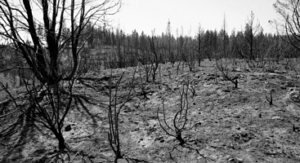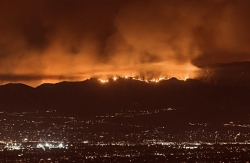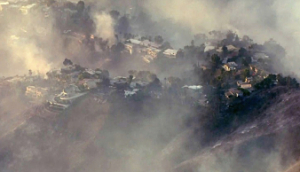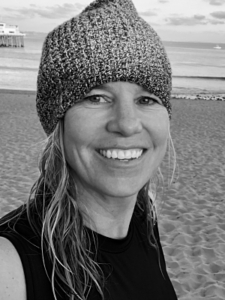The Next New Normal

June 2015, John Muir Trail: The child knew there was something wrong when we approached the burn zone—blackened trees, scorched rocks, a new kind of crunch under our hiking boots. The sun was blazing, our packs heavy. Hours later, when we reached a green zone with a stream running through and two glorious stags in the tall grass, we made camp. As night fell the child said, “If saving the earth, means we have to go, I think that’s okay. We should go.” Her older sister argued the value of humans, our light and our darkness, the beauty of Shakespeare, the positive contributions of Buddha and jazz. The nine-year-old held her dog close, unmoved. “I just think the planet might be better off without us.”
July 2017, Central Valley: “Cow carcasses pile up in California as heat wave causes mass death,” CBS announces. Under a cool moon, I can still feel the heat of burnt houses and dead livestock. I joke to a friend that maybe tonight calls for hamburger, in solidarity, in the name of not letting those animals go to waste. And let’s drink something that makes our throats burn too, burn more than they already do. Let’s down the dust of dry riverbeds with a shot glass. Let’s take the particles of the undone, unrivered, unfielded, and unhoused, bring them into our bodies. Ashes to ashes. Cheers.
September 2018, Los Angeles: At the gas pump I think how the juice of dead dinosaurs and giant ferns fuels my car, how I’m driving around, burning the energy of that collapsed, green world. Nothing more than dead plant matter mostly—horsetails and palms, magnolias as big as dinner plates, bronto-salad. First, wood for a cookfire, then charcoal also to heat ore, and later the quaint trains and steam ships. Now nearly our whole world is powered by the last extinction. What will our extinction power? The blacktop is giving off those wiggly waves of heat. I’m steps from the strangled LA river, denatured and paved, starved of most of its water yet still creating islands of life, nests for birds. We will be used in ways we cannot even imagine. This gives me some kind of pleasure when I click the gas pump back in place, screw the cap, put the car in drive and go.
January 2018, Santa Barbara County: “Southern California mudslides: 17 dead, others missing,” CNN. First there was the Thomas fire in December, the largest wildfire in California history— 281,000 acres burned. People I knew in Ojai had been evacuated, more than once. Then came the rain. And more rain. Tearing down bald hillsides, no live trees or brush or grass, no root systems to hold the earth in place. A friend had moved from  Chicago to Montecito in September with her family, for the dream of California sunshine. On January 9th her twin girls discovered a dead, mudded human body by their house. In September, it was all about caftans and the thrill of a winter without sleet and snow. Now she sounds like a pioneer from a former century: clean up the muck, honor the dead, and rebuild. My friend, she talks about how the tragedy has bonded her with her new community. But not everybody stays.
Chicago to Montecito in September with her family, for the dream of California sunshine. On January 9th her twin girls discovered a dead, mudded human body by their house. In September, it was all about caftans and the thrill of a winter without sleet and snow. Now she sounds like a pioneer from a former century: clean up the muck, honor the dead, and rebuild. My friend, she talks about how the tragedy has bonded her with her new community. But not everybody stays.
July 2018, Los Angeles: A heatwave obliterates all previous record highs. Triple digit temperatures across most of L.A. and further south. The last five years have been the hottest in 124 years of record keeping. This is no fluke, scientists warn. This is climate change, and it’s only getting worse. I read about birds dying in Death Valley from the extreme temperatures. Birds don’t sweat, I learn. They puff up their feathers to cool themselves and pant. Park rangers find groups of song birds huddled around small puddles, tiny beaks open to the hot air. “This isn’t normal for us,” says a spokeswoman for the National Park Service. I used to love the desert, its vast indifference blasting open my cramped soul. Now I think about the birds.
September 2018, Los Angeles: What is the world’s driest desert? Starts with an A. For once, I don’t need to rack my brain to remember the name of the chief justice on the Supreme Court in 1972, or scrunch up my face to recall the French word for song. Atacama, I scratch into the empty squares. It’s in Northern Chile, known to gringos as The Valley of the Moon. Years ago, on my 21st birthday, my friends and I arrived there at night. A pile of scraped knees and backpacks, bottles of pisco and sleeping bags rolling out of the pickup truck like a scratchy tune. Past the taillights, blackness, a night blacker than any night I knew. At dawn, I unzipped my tent and crawled into the most spectacular landscape of pink dunes and white salt, rock ledges licking the blushing light, boulders the size of cars, abandoned in smooth expanses of sand. The Andes rose sharp and snow capped to the West, like the back of a dead dragon. This is it, I thought, and a restlessness stilled in me, like a squirrel beds down for winter. Here, my own secret landscape meets this one, recognizes this one. I was twenty-one, on my knees, not a living thing in sight. I felt at home. We walked miles through a tambourine of heat to an art deco swimming pool bridged by an arched iron filigree, centered on top of a round pergola like a 1940s version of a UFO. No one could tell us when exactly it was built, for whom, or why. I didn’t even understand where they got the water to fill it.
November 2018, Los Angeles: “Mom, my eyes hurt.” It’s the fires. I get the drops. No sports this afternoon. No school in some places. California is burning. Again. A town called Paradise is wiped off the map. Later there will be studies and opinion pieces, more talk of global warming, and a president who tells us we should rake our millions of acres of wilderness “like the Finns.”  Sparking electric lines and tinderbox conditions will be blamed for the burning of 153,000 acres up north in Butte county and 97,000 acres down south in L.A. There will be a mass shooting at a bar in Sherman Oaks that will feel connected, horror begetting more horror. For now though, as heroic firefighters battle the blazes, my young daughter and I deliver homemade cupcakes and power bars to our fire station, clothes to Malibu, money to Paradise, just to do something. Everyone seems to know someone who knows someone who lost a house. The sunsets are a terrifying orange. Our state is burning, people are dying. At dusk I stare at the browned front lawn. The bark from the eucalyptus trees peels off in strips. The air buzzes with crickets or cicadas, some creature that feels at home in this heat, can still make noise, still with an appetite for eating and mating. Me, not so much. The acrid air claws at my throat like a dying thing wanting to escape, like a despair wanting to birth itself from my mouth and say, you wanted a better future for you and your children, but look around you. Look.
Sparking electric lines and tinderbox conditions will be blamed for the burning of 153,000 acres up north in Butte county and 97,000 acres down south in L.A. There will be a mass shooting at a bar in Sherman Oaks that will feel connected, horror begetting more horror. For now though, as heroic firefighters battle the blazes, my young daughter and I deliver homemade cupcakes and power bars to our fire station, clothes to Malibu, money to Paradise, just to do something. Everyone seems to know someone who knows someone who lost a house. The sunsets are a terrifying orange. Our state is burning, people are dying. At dusk I stare at the browned front lawn. The bark from the eucalyptus trees peels off in strips. The air buzzes with crickets or cicadas, some creature that feels at home in this heat, can still make noise, still with an appetite for eating and mating. Me, not so much. The acrid air claws at my throat like a dying thing wanting to escape, like a despair wanting to birth itself from my mouth and say, you wanted a better future for you and your children, but look around you. Look.
October 2019, Los Angeles: Of course, there are steps to take and I’ve been taking them. I march. I write my congress people. I join organizations. I buy the Impossible Burger. I wait three months for my lease to end so I can trade it in for an electric car. At Home Depot, I snap pictures of cacti and gravel for the yard. None of this makes me feel better. When I look at a map of the earth enveloped in yellows, burnt orange, and deep red, I know I’m kidding myself. Mass extinction has begun. We are headed toward an eco-collapse. What to do in the meantime? Walk my dog along a dry ridge of Griffith Park above my house, take in the view of brown smog below bleeding into the horizon. Make a mental list of what to pack in case of fire. Recycle. Pay Sierra Club dues. Buy Paul Hawken’s Drawdown: the most comprehensive plan ever proposed to reverse global warming. Panic. Skip ahead some pages – Desdemona dead already, Oedipus blind. Catharsis.
 November 2019, Los Angeles: My daughter and I leave the house for school, a layer of grit and ash covering my car, my lips, my teeth. How long will it be until we are all wearing masks? I look over to see my daughter’s pout, the same way she bites her bottom lip when she’s nervous before a test. If she wears a mask, her expression, I’ll only see it through her eyes. I’m so afraid of the next new normal.
November 2019, Los Angeles: My daughter and I leave the house for school, a layer of grit and ash covering my car, my lips, my teeth. How long will it be until we are all wearing masks? I look over to see my daughter’s pout, the same way she bites her bottom lip when she’s nervous before a test. If she wears a mask, her expression, I’ll only see it through her eyes. I’m so afraid of the next new normal.
Liz Tynes Netto is a lapsed journalist, TV producer, and resident of Los Angeles. Her poems have appeared in The West Trestle Review, The Mas Tequila Review, The Lummox, Lady/Liberty/Lit and others. A current MFA candidate at Antioch University in Fiction, she is writing a novel.





